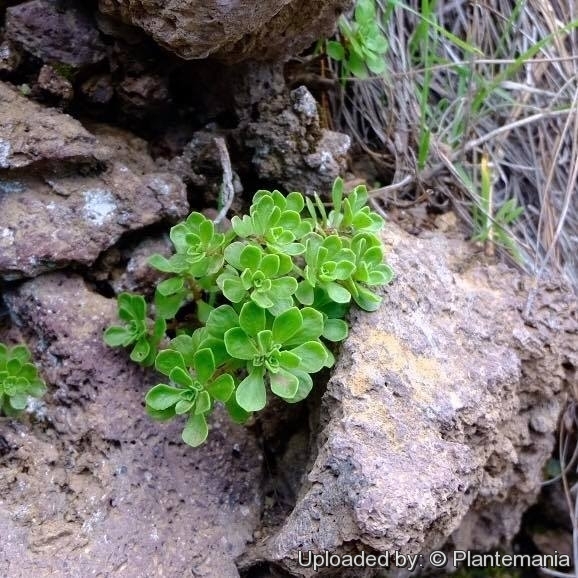
Aeonium spathulatum Photo by: © Plantemania
Growing habit, Tenerife, Canary Islands, Spain, 14 February 2018.
Origin and Habitat: Canary Islands, Spain. Aeonium spathulatumSN|34872]]SN|34872]] is the most ubiquitous species, which occurs on Gran Canaria, Tenerife, Gomera, La Palma, Hierro, with the exception of Lanzarote and Fuerteventura.
Altitude range: 250 - 2500 metres above sea level
Habitat and ecology: Aeonium spathulatumSN|34872]]SN|34872]] is locally frequent on cliffs, ravines and rocks crevices; especially within the montane to subalpine pine forest belt at altitudes of 800 to 2000 meters. Flowering time is from March to June.
Synonyms:
See all synonyms of Aeonium spathulatum
back
Accepted name in llifle Database:Aeonium spathulatum (Hornem.) PraegerProc. Roy. Irish Acad. , B 38: 482 1929.Synonymy: 16
back
Common Names include:
SPANISH (Español): Bejeque, bejequillo canario, canjequillo canario
Description: Aeonium spathulatumSN|34872]]SN|34872]] is a perennial succulent shrublet between 20 and 65 cm tall (depending on the form). It is very bushy, has slender branches and small spoon-shaped sticky leaves. The flowers with 8 to 10 petals are golden yellow. Aeonium spathulatumSN|34872]]SN|34872]] belongs to the group of small shrubby species, with branched stems and short leaves. It differs from other species because the leaves, obovate-spatulate and small, have linear glands on the underside and ciliated margin, the branches being smooth, not reticulated. There are two varieties: var. spathulatum and var. cruentum (Webb & Berthel.) Praeger, the latter only in the islands of El Hierro and La Palma.
Derivation of specific name: spathulatum, for the leaves that are spatulate (with a broader, flattened end).
Stem: Densely branched, branches, woody 1-3 cm in diameter, puberulent, smooth, without reticulations.
Rosettes: 1-5 cm cm in diameter, more or less flat to distinctly cup-shaped, inner leaves more or less erect. In summer the leaf rosettes will close completely, and they will open again at lower temperatures in autumn.
Leaves: 5-25(-30) mm long, 3-9 mm wide, 1-1.5 mm thick, obovate-spatulate, apically obtuse, basally cuneate or attenuate, puberulent (finely hairy) and a bit sticky; lower face at first green, later brown, with conspicuous longitudinal brownish tannic stripes and sunken oblong glands. Margin with translucent bead-shaped cilia (0.7 -1 mm long). In summer, the leaves are often dropped, except for the youngest.
Inflorescence: Floriferous part lax, 3-10 cm long, 3-15 cm broad; peduncle 5-20 cm tall; Pedicels 1-10 mm long, puberulent
Flowers: 8- to 10-merous; Sep puberulent; Petals 4.5-6 mm long, 1.5-2 mm wide, elliptic, obtuse, yellow, often with reddish lines; Filaments glabrous.
Chromosome number: 2n = 36.
Notes: Aeonium spathulatumSN|34872]]SN|34872]] is quite variable, the El Hierro form is smaller than the typical form from Tenerife. The La Gomera form is much taller and more upright growing with slightly smaller and sticky, fresh green leaves with an acute tip on greyish brown stems. The form from Gran Canaria is more compact with slightly larger, strongly sticky leaves with a triangular like, broad flattened tip, and it is native of central parts of Gran Canaria.
Bibliography: Major references and further lectures
1) Urs Eggli “Illustrated Handbook of Succulent Plants: Crassulaceae” Springer Berlin Heidelberg, 05/Nov/2012
2) N.S. Margaris, Margarita Arianoutsou-Faraggitaki, W.C. Oechel “Being alive on land: Proceedings of the International Symposium on Adaptations to the Terrestial Environment Held in Halkidiki, Greece, 1982” Springer Science & Business Media, 6 December 2012
3) Lorraine Harrison, “Latin for Gardeners: Over 3,000 Plant Names Explained and Explored” University of Chicago Press, 21 September 2012
4) John Robert Brown, Alain Campbell White, Boyd L. Sloane, George W. Reynolds “Succulents for the amateur: introducing the beginner to more than eight hundred fascinating succulent plants” Abbey garden press, 1946
5) Myrtle Ashmole, Philip Ashmole “Natural History Excursions in Tenerife: A Guide to the Countryside, Plants and Animals” Kidston Mill Press, 1989
6) Aeonium spathulatum at: Tropicos.org. In: IPCN Chromosome Reports. Missouri Botanical Garden, St. Louis web: http://www.tropicos.org/Name/8902637?projectid=9
7) Ingrid & Peter Schönfelder, “Kosmos Atlas Mittelmeer- und Kanarenflora”, Stuttgart 2002
8) Hohenester & Welss: “Exkursionsflora für die Kanarischen Inseln”, Stuttgart 1993
9) Aeonium spathulatum (Hornem.) Praeger in: Flora de Canarias, web: http://www.floradecanarias.com/aeonium_spathulatum.html
10) Aeonium spathulatum in: rareplants.eu web: http://www.rareplants.es/shop/product.asp?P_ID=6481










